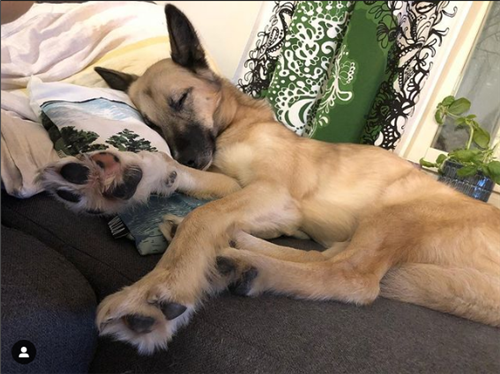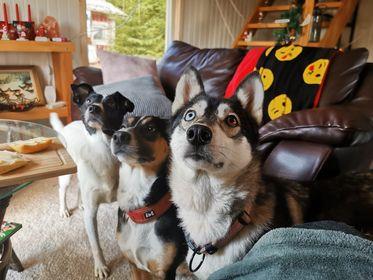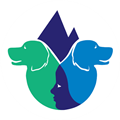FAQ Huskies and Sled Dogs Adoption
Let's answer all your burning questions!
"Too wild “, “no good house dogs “, “feeling insecure inside the house “,” not made for being inside “, “aggressive with other dogs”....
This FAQ is meant to answer the most common questions I receive when it comes to adopting a husky or former sled dog. If you have any other, please drop me a line, and I will make sure to answer and add it to this list!

About adopted dogs in general
Most of the dogs for adoption come to our shelter for the transitioning period. If they don’t, it is simply because their owners are trusted partners and the information provided about the dogs are reliable.
We take time to assess the dog, train or practice the basics that a pet dog must know: walk on the leash, being indoors, be around “normal” dogs. Some already know or learn quickly how to sit or even lie down on command, others don’t.
As any adopted animal, they need some time to get used to you, their new surroundings and new life. Some things, unusual sounds, or some situations might scare them, as everything is so new for them. Be patient, as you would with a puppy, and trust their ability to understand and learn quickly. As adult dogs, they will pick things much more quickly.
We recommend not to let the dog off the leash until you have practice recall and other obedience exercises enough to be confident that your dog will come back. Again, this is common sense and apply to any dog we own and are therefore responsible for.
I’ve heard many times of the “3 days- 3 weeks -3 months” rule. 3 days to understand that they are with you. 3 weeks to start trusting you. 3 months to be your dog. I’m not a big fan of these kind of fixed rules. If it helps you, use it. I personally recommend that you learn to read and understand your dog, to know them, to feel when you can or cannot let them free. I think dogs are smarter than us humans… and maybe it is rather the humans who need these 3-3-3…
One tip to help your newly adopted husky feel good with you and in their new life:
Make them succeed at any new thing they learn or obstacle or fear they overcome! And they will feel proud and happy to repeat it again!
About fears and being home alone
Fireworks, thunder, etc are trouble for many dogs! Yet not always as much for kennel dogs. If it be the case, I have a technique that I've used with all my dogs for fear of thunder and fireworks, and it really works wonders. You can check the article there. This dog used to jump over fences or destroy the house when scared!
About being left alone in the house: I recommend that you try for a short time before leaving your husky home alone for several hours. You can use a fly box to leave them inside while you are away, especially at the beginning or until you know your dog’s reactions well enough. It is usually a safe place for them, as they don’t have to protect the entire house or worry about where you are gone. If you have an outdoor place for them, you can also leave them there, during your absence.
About Huskies and cold/warm temperatures
There is this common sense, that huskies are made for the cold. They don't bother about temperatures way beyond zero. Which is kind of true. The fur of a Siberian husky, a Greenland dog, an Alaskan Malamute, Laika ... all kind of "original sled-dog breeds", is thick enough and has different layers, that are working as an air-condition in summertime and a heating system in winter.
Most of the huskies – most of those for adoption!, which are used for modern sled-tours are NOT these original types anymore.
The easiest dog in handling, speed and "desire to go" is the Alaskan husky.
Very often, they don't have the same fur quality like Siberian, because the emphasis in "breeding" them, is their drive to run, to pull. So they are mixed with different breeds made for running.
Of course, other qualities are also considered, such as fur quality, resistance of the paws, good eaters, etc.
Can all Huskies resist temperatures below -20? As mentioned above, they can but depending on their breeds, they will need different conditions: wooden doghouse and companions, insulated doghouse, etc. But, if given the opportunity, they will always choose the comfiest solution. So usually, once you bring your husky inside and they get used to it, they definitely prefer the comfort of a house than being out in the cold. Yet, among my 10 dogs (rehomed, but still working as sled dogs or active outdoor dogs), I have some that prefer to stay outside most of the time, even though they are perfectly well inside too. Bobby, for instance, likes to be outside, and comes inside for cuddles; Quint, his brother, is the typical “no fur” husky, and doesn’t go outside in winter without his coat and booties…
What about hot temperatures? Huskies will handle warm temperatures too. As mentioned above, some don't have such a thick fur. We have a former sled dog now living in Sardinia by the beach..! They will shed, for sure, and be ready to brush your new companion regularly in spring time! As for many dog breeds, beware of too intense exercise in hot temperatures! Check your dog and make sure they don't overheat and stay well-hydrated. Temperatures can be very high also in the Nordic countries, Alsaka, Canada, etc where you find many huskies. So this isn't something new to your furry friend. I wrote a post on hot temperatures and dogs on one of my blogs. Read it there
About Sled Dogs inside the house
I’ve heard so often about huskies not being good inside dogs… and seen so many proofs of this statement being so wrong! I have re-homed or helped re-home over 30 dogs by now, and they have all – I mean literally all – settle in in their new life as home dogs. Of course, the dogs available for adoption are dogs that have a potential to be re-home. Those with a very heavy history, traumatised (for whatever reason) or not at all into people are usually not offer for adoption at all, or only after some time spent at our place for some re-training, socialising, etc., and making sure they are ready for a life as a pet dog.
They might be at first afraid of the stairs, especially open staircases, of sleek floors, of dark corners, of passing doors too. Just be patient. Give them time to see, sniff and if needed, carry them over the obstacle once or twice. Once they get how nice it is on the other side and have seen that nothing dangerous was hiding there, they will go with more and more confidence each time. As said earlier, make them succeed! And they will feel proud and happy to do it again!
Have a quiet corner or place in the house for your dog. So they know where they can go and rest when they need to. This place will be their safe corner, and it can also be a good spot for them to stay and wait when you are away for instance or have guests coming.
Usually, the dogs are clean inside from the very first day. That’s one good side of having an adult dog, not a puppy! A pee can happen on the first day, especially for males, as they are marking their territory or if the dog is a bit stressed out. Take them outside regularly and be firm that inside is a “no pee” place. One of my males peed inside on one occasion: another male dog came to visit and he had to show that it was his home...
About language
Don't worry about language! First because the sled dogs are usually used to at least two different languages due to the people taking care of them in the kennels. Second because animals pick up primarily on your body language and thoughts, and then learn very quickly what word means what, or what action is required when you use this word or another.
About food
Huskies usually eat meat, fish, bones, and dry food/kibbles.
When changing home, some might not be very good eaters at the beginning. This is due to the stress related to the change of place, people, etc. It can last between one to several days. It can take up to two weeks! You can feed them ready-made dog sausages (with plain meat or meat & rice, in all animals specialised shop) to help. Don’t worry, it will pass, and they will soon be good eaters again!
If your newly rehomed huskjy doesn't eat at all, please do the following:
- understand that your dog is sad, stressed by the recent changes, and needs time to integrate the new situation; trust in their ability to adapt and give them time to settle in. They will resume eating when time is right.
- leave some dry food in a bowl (if possible) and just ignore them or what they do about it. They might start eating later or when no one is watching, during the night.
- make sure they have a bowl of fresh water available at all time.
- take off the pressure on them and on yourself about them not eating; stop worrying and stressing about it - it will only make things worse as they pick on your energy. Of course if the issue persists after two weeks, with no signs of improvement, please contact your vet.
- focus on creating the bond with your new friend: do some fun and enjoyable activities, go for longer walks or runs, start teaching them new things, practise recall, educational basics and other training exercises.
I like to give some raw meat (like 1/3 meat and 2/3 kibbles), and some snacks to chew for their teeth. Some dogs don’t really know about snacks yet, but they will learn and appreciate them quickly! You can buy them mainly dry food, as it is often easier daily. They do also very well on raw food diet.
Just beware that most Alaskan huskies tend to be leaner than Siberian or other more rustic Arctic breeds. They are the Husky “Greyhounds” 😉
Which Brand?
I don’t want to recommend any brand in particular here. It depends so much on where you live, your budget, etc. Go for dry food with more meat and little or no grain (I prefer rice to wheat). The percentage of fat depends on how much meat you give to your dog. If you give meat on a regular basis, go for kibbles containing less fat, especially if you have a retired dog, doing little exercise. Of course, if your dog is being very active, you should feed them accordingly. If your dog has diarrhoea or other digestion issues, try another brand. Some cooked rice with raw meat is also a good solution.
About exercise
How much exercise your dog needs depends on its age, breed, and overall fitness. Huskies are not born fit, and they are trained to be able to run so many hours in a row. Huskies to be re-homed are either retired working dogs or younger dogs not suitable as professional sled dogs.
Basically, sled dogs for retirement have done a lot of exercise all their life, and don't need as much in their retirement years. They often are already doing less in their kennel, and sometimes stay in their fences most days, or go to the free running fence. What they need most is regular activity, yes, but also care and attention. Working dogs, who enjoyed running and being with people can get bored if they stay at the kennel. They are happier being part of a family and being cared for. So, if you can take them out on a regular basis and do longer walks once a day or every other day, they will be totally fine.
Now younger dogs to be re-home will need more exercise, like any young dog from an active breed. They probably haven’t done so many hours of training or didn’t enjoy it, that’s why they are re-homed. However, most of the time they will do amazing sports or leisure buddies, ideal to go on hikes, ski, or bike tours.
For the younger dogs, the amount of activity they need will be specified in their profile.
About kids, other animals and dogs
Huskies are pack dogs. It means they are used to be with other dogs and play, act by dogs’ rules. Usually, they are very friendly with other dogs and like to socialise. If not, it will be specified in their profile.
Some dogs will be totally fine alone, some will need company of another dog or companion. This is specified in their profile.
With other animals, such as cats, horses, chicken, etc: it's like with any other dogs, your new companion needs to learn what other animals are, and that they are not allowed to touch them. We have some rehomed huskies who are now farm dogs and never touch the chicken; I have many examples where it is fine with cats. My own two home huskies often share the same bed with my cat. At our place, we have horses, so most of the dogs for adoption have been around horses before coming to your place.
If the dog has a very strong hunting instinct, we will mention it in their profile. Yet, it doesn’t mean they will not be fine with your cat or your other animals. Quint is a hunter, always on the leash in the woods… yet he has learnt to differentiate cats and never ever run after them.
With kids. In the working kennels, dogs are in contact with a lot of people, kids included. Usually, they are very nice to them and will certainly become best friends very quickly. Sometimes, they can be a bit awkward near toddlers and young children at first, as they don't really know how to behave with them . Younger dogs can also very energetic. But this will really depends on the dog. If we think a dog isn't suitable at all for a family with young children, we will specify it in their profile.
About vaccinations and passport
We only have dogs with vaccinations in order for adoption
Some have a chip and passport, others only the chip and a vaccination card. This is specified in their profile.
About adoption terms & conditions
Adoption fee is 250€ unless specified otherwise.
There's a 14-days trial period - you can return the dog and get the money back.
A simple written contract will attest the above.
If anything happens in your life and you cannot keep the dog, you must return it to me (we don't want dogs to end up in shelters...)
I know that you're far away, but adopted dogs can come for holidays at my place at a discounted price
The health status of the dog is always mentioned in their profile, along with any special need or diet. It is the state known to this day.
We cannot be held responsible for anything happening to the dog once they leave our place. Healthwise, if anything happens during the 14-day trial period, let us know immediately.
The dog comes with a collar, papers, and anything the former owner gave us for you! You can get leashes, harnesses or walking belts from us, if you wish.
First and foremost, we wish you an AMAZING time and lots of FUN with your new furry friend!

 Life is an Adventure full of Magic & Animals
Life is an Adventure full of Magic & Animals